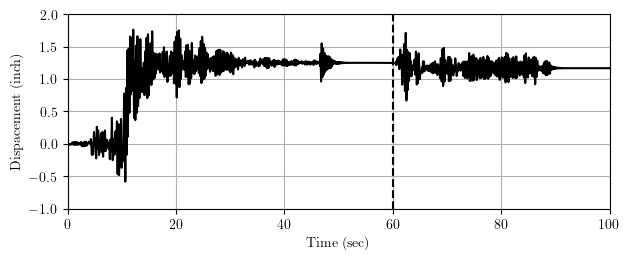OpenSees Cloud
OpenSees AMI
Sequential Ground Motions
Original Post - 18 Nov 2024 - Michael H. Scott
Show your support at Buy Me a Coffee.
How to impose sequential ground motions while keeping the damaged state of the model from the end of one ground motion to start of the next is a question asked with moderate frequency (including today, which encouraged me to take this post from draft to reality).
Below is a minimal working example where two ground motions are applied in sequence. Let’s say we’re imposing an El Centro ground acceleration record after a Tabas ground acceleration. Obviously, which ground accelerations we use is not important for this example.
The model is an EPP SDF system with mass, m=1 kip*sec2/inch, stiffness,
k=600 kip/inch, strength, Fy=300 kip, and 5% damping. Use the -startTime
option for the time series of the second ground motion. You will also
have to define a uniform excitation load pattern for each ground motion,
which is not a big deal. And you don’t have to do anything special to
carry damage over from one ground motion to the next–it’s all one
analysis.
import openseespy.opensees as ops
ops.wipe()
ops.model('basic','-ndm',1,'-ndf',1)
# Units = kip,inch, sec
g = 386.4
m = 1
k = 600
Fy = 300
zeta = 0.05
wn = (k/m)**0.5
c = 2*wn*m*zeta
ops.node(1,0); ops.fix(1,1)
ops.node(2,0); ops.mass(2,m)
ops.uniaxialMaterial('Elastic',1,0,c)
ops.uniaxialMaterial('Hardening',2,k,Fy,0,0)
ops.element('zeroLength',1,1,2,'-mat',1,2,'-dir',1,1)
ops.analysis('Transient','-noWarnings')
ops.timeSeries('Path',1,'-dt',0.02,'-filePath','tabasFP.txt','-factor',g)
ops.timeSeries('Path',2,'-dt',0.02,'-filePath','elcentro.txt','-factor',g,'-startTime',60)
ops.pattern('UniformExcitation',1,1,'-accel',1)
ops.pattern('UniformExcitation',2,1,'-accel',2)
Tfinal = 100
dt = 0.01
Nsteps = int(Tfinal/dt)
for i in range(Nsteps):
ops.analyze(1,dt)
The displacement response history of the EPP SDF system is shown below, where it is clear the damaged state from the end of the first ground motion is the initial condition for the second ground motion.
